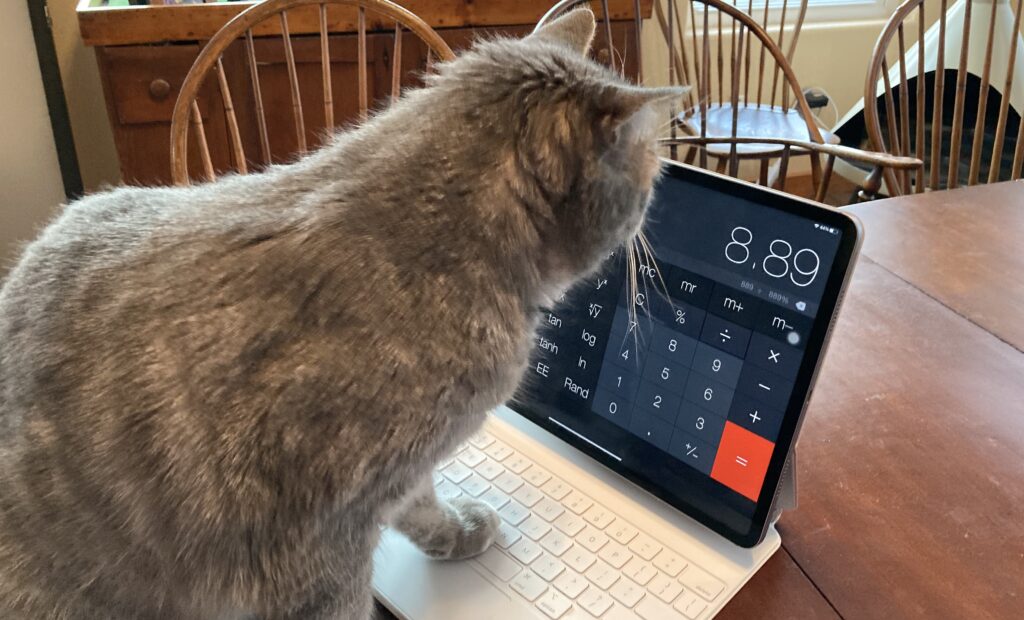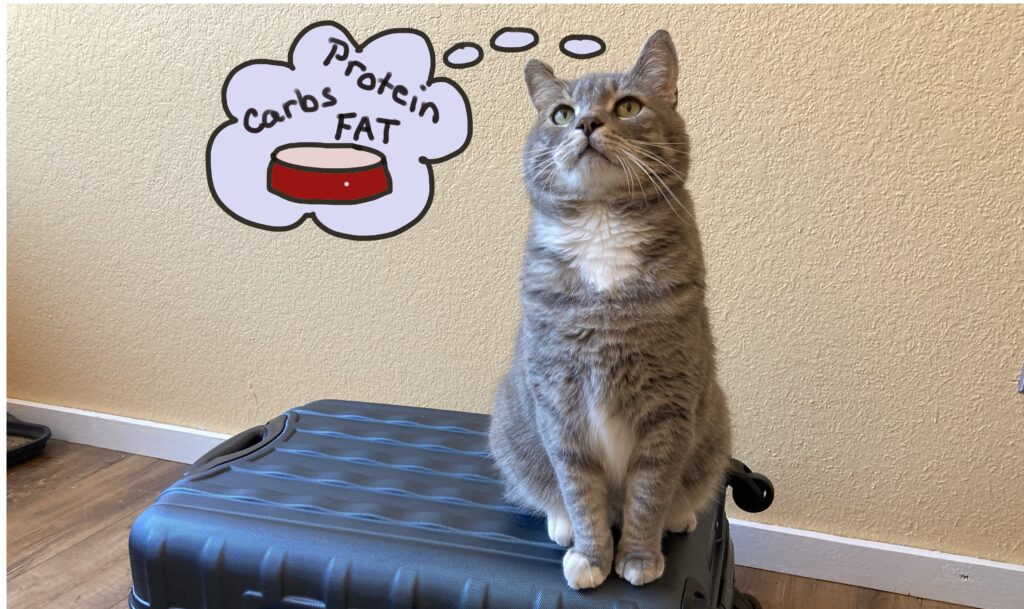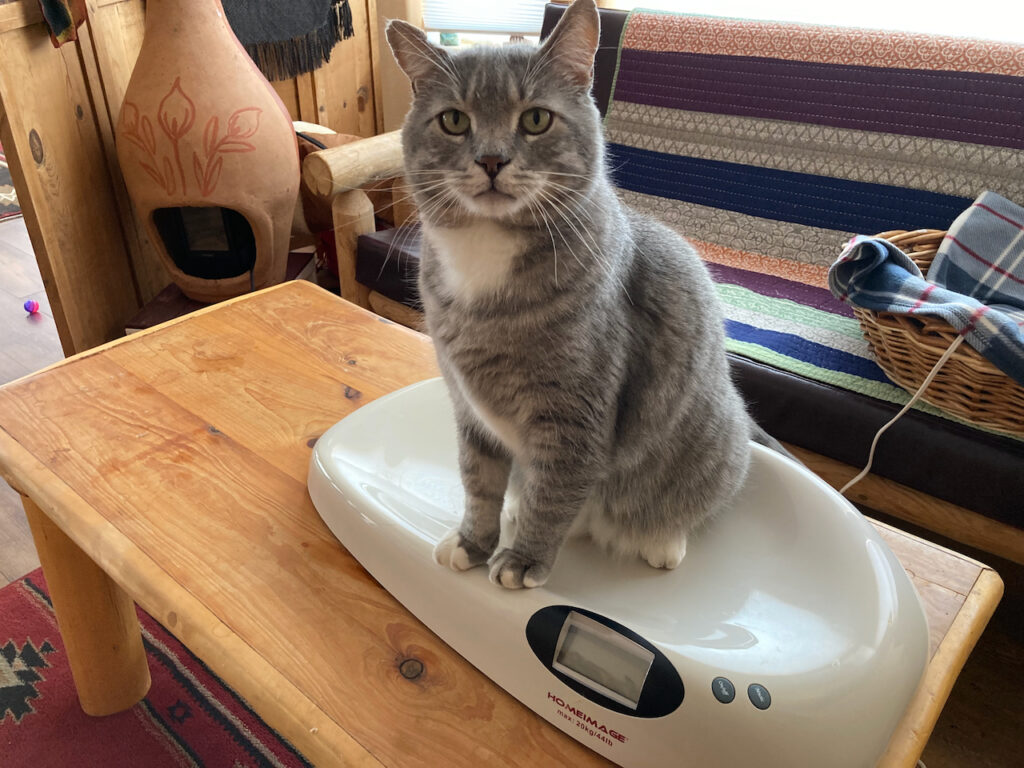 If your cat consumes more calories than she burns, she will gain weight. So, how many calories should your cat eat in day to maintain a healthy body weight?
If your cat consumes more calories than she burns, she will gain weight. So, how many calories should your cat eat in day to maintain a healthy body weight?
Like people, cats are individuals; some have higher metabolisms than others. Things that affect how heavy or thin a cat is include (Reference 1):
- Genetics
- Sex
- Spayed? neutered?
- Hormonal changes eg. hyperthyroidism, diabetes
The feeding guidelines on cat food cans or packages are a start but they can be misleading. Many of these guidelines are based on feeding intact cats and often recommend 25-35% more food than most housecats (spayed or neutered) need to eat. Immediately after spaying or neutering, the cat undergoes hormonal changes (changes in estrogen, progestin, insulin-like growth factor) that affect metabolism. The results are an increased appetite, decreased energy requirements, changes in glucose tolerance and fat metabolism. (Reference 1)
How Many Calories Should Your Cat Eat in a day?
A Rule of Thumb
- Most average-sized (9 to 11 pounds) spayed and neutered cats need to eat about 200 kcal daily to maintain lean body condition.
- Neutered males may need to eat less, about 180 kcal/day. (Reference 1)
Monitor your cat’s body condition
- Be attuned to factors that can lead to weight gain or loss, such as disease (hyperthyroidism), feeding behavior (a cat eats another cat’s food) or lifestyle change (access to a catio).
- Monitor your cat’s body weight, his body condition score and his muscle condition score regularly.
How Many Calories Should Your Cat Eat?
Weigh Your Cat
You can weigh your cat at the veterinary clinic but, even better, purchase a baby scale to weigh your cat at home. This is more convenient, especially if your cat is on a weight-loss program and needs to be weighed frequently. You can make this fun by training your cat to get on the scale for a yummy reward (something low calorie, of course!)
“How Do I Look” – the Body Condition Score (BCS)
Look at your cat’s profile from above and from the side. Ideal body condition is defined as a visible waist (when viewed from above) and tummy tuck (side profile). You should be able to easily feel his ribs under his skin and fur. Compare what you see with the pictures on the Body Condition Chart. Give your cat a score.
Once you know your cat’s weight and Body Condition Score, you can get a calorie estimate from a convenient calculator at https://petnutritionalliance.org/resources/calorie-calculator?type=cats
How Many Calories Should Your Cat Eat?
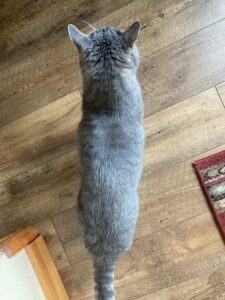
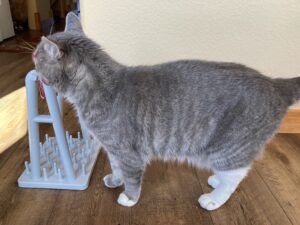
Here are some photos of Gus, who currently weighs 12.50 pounds. You can feel his ribs but there is some fat over them. His waist and shoulders are distinguishable but he does not have much of an abdominal tuck. We will give him a BCS of 6. The Pet Nutrition Alliance site recommends an ideal weight of 11.4 lbs and 216 kcal daily for weight loss.
Lean Body Mass and Healthy Weight
In a previous post, we talked about Lean Body Mass (LBM) and the benefits of a higher LBM for cats:
- A higher percent of muscle will boost your cat’s metabolism
- Make it easier for her to maintain a health body weight
- Can help your cat live longer.
Choosing a diet to promote LBM – A Math Problem
Studies indicate that to maintain LBM, a cat should consume around 5.2 g protein per kg or 2.3 g protein per pound. (Reference 2). Using your cat’s weight, you can multiply by 2.3 (weight in pounds) or 5.2 (weight in kg) to estimate the protein he or she needs. Gus weighs 12.5 lbs and needs 28.8 grams of protein daily.
Here are two canned foods and two dry foods, with guaranteed analysis and protein content. As you can see in the chart, there is only one food (wet) out of the 4 foods that will provide Gus with the protein he needs while he loses weight eating 216 kcal daily. Food 2 can give him the 28.8 g protein in 183 kcal. (See “How Much Protein Should You Feed Your Cat?” for estimating the amount of protein in a food.)
|
Food 1 (wet) |
Food 2 (wet) |
Food 3 (dry) |
Food 4 (dry) |
|
| Crude Protein (%) |
10 |
11 |
42 |
42 |
| Crude Fat (%) |
5 |
2 |
19 |
9 |
|
Crude Fiber (%) |
1.5 |
1.5 |
3.2 |
5.0 |
| Moisture (%) |
78 |
80 |
12 |
12 |
| Ash (%) |
3.2 |
3.5 |
0 |
0 |
| Carbohydrate (%) |
2.3 |
2 |
23.8 |
32 |
| MER (kcal/kg) |
942 |
700 |
4342 |
3770 |
| Protein (g/ 100 kcal) |
10.6 |
15.7 |
9.7 |
11.1 |
| Cat’s weight (lbs) |
12.5 |
12.5 |
12.5 |
12.5 |
| Protein for LBM |
28.8 |
28.8 |
28.8 |
28.8 |
| Calories of Food Needed (kcal) |
270.8 |
183.0 |
297.2 |
258.1 |
The muscle condition score
There is one more thing we need to monitor – the cat’s Muscle Condition Score (MCS). Loss of muscle over the spine, shoulder blades, skull, and hips (that “bony” feeling) is an indicator of LBM loss. Although you cannot prevent loss of muscle due to aging, you may be able to slow it down by feeding a higher protein diet. Here is a chart to help score the muscle condition. Gus, at age 7, still has normal muscle mass, which we will try to maintain by ensuring he gets enough protein in his diet.
Feeding your cat is more than just how many calories should your cat eat. We must balance calories and nutrients and monitor weight, BCS and MCS regularly to make sure the feeding plan is working. AAFCO labeled foods ensure that your cat receives the basic nutritional requirements. Optimal nutrition for the individual cat, especially one with medical conditions, may require a more detailed plan and possibly the services of a board-certified veterinary nutritionist.
references:
- Zoran, Debra. “Feline Obesity: Clinical Recognition and Management” Compendium, June 2009 (Vol 31, No 6).
- Laflamme DP, Hannah SS. Discrepancy between use of lean body mass or nitrogen balance to determine protein requirements for adult cats. Journal of Feline Medicine and Surgery. 2013;15(8):691-697. doi:10.1177/1098612X12474448
Want to keep up with the world of cats? Subscribe to The Feline Purrspective?

